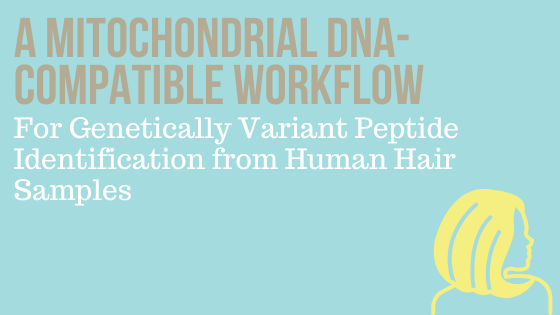Hair is an evidentiary sample that typically does not provide sufficient nuclear DNA for forensic analysis. Therefore, state-of-the-art forensic examination for hair samples include subjective microscopic evaluation, mitochondrial DNA (mtDNA) analysis, and more recently, proteomic genotyping (hair is composed of up to 95% protein by mass) that uses protein variation in the form of genetically variant peptides (GVPs) to infer single nucleotide polymorphism (SNP) alleles.
Written by: Lindsay Catlin, Battelle Memorial Institute
The forensic value of proteomic-based GVP analysis and mt-genome analysis from hair had been established separately, but mtDNA-compatible proteomic methodologies were lacking. Given limited sample amount in many cases, recovery of DNA will likely be the priority for forensic evaluation, thus excluding a strictly proteomic approach as a useful tool.
Since many cases involve limited sample amounts (approximately 2 cm or less), any additional destructive testing (besides mtDNA) would be excluded. If a mtDNA-compatible protein extraction workflow could be developed, GVPs would provide additional forensic value without sacrificing any portion of the original hair sample.
In our paper, we demonstrate an optimized method that can be used to obtain both whole genome mtDNA and putative GVP profiles from a single limited hair sample.
The method involves urea-based extraction of proteins from hair, followed by buffer exchange and protease digestion. Peptides are eluted through a 30 kDa membrane and analyzed using traditional proteomic techniques [reverse-phase microflow liquid chromatography coupled with high resolution quadrupole time-of-flight mass spectrometry (μHPLC-Q-TOF-MS)]. DNA is subsequently extracted from the filter and analyzed using whole mt-genome analysis.
The method was verified with a range of hair sample types (head, pubic, and arm hair) from a diverse cohort of 22 individuals. Specifically, putative GVP profiles and mtDNA haplotypes concordant with buccal swab samples from the same donor were obtained from 22 individuals. Further, the utility of the method was verified across two different laboratories (Battelle and UC Davis).
The method is applicable for proteomic-based GVP analysis and mt-genome analysis for forensic research applications. We expect the results from this study to have an immediate impact on current proteomics research for human identification purposes.
Researchers will be able to analyze proteins from valuable samples without sacrificing DNA quantity or quality. We consider this program to be the first step in the path to ultimate implementation of our method into routine forensic laboratory analysis. Further, the method can potentially be modified for other sample types, such as touch samples.
For more in-depth information, please read our paper in FSI:G (LA Catlin, RM Chou, ZC Goecker, LA Mullins, DSBSS Silva, RR Spurbeck, GJ Parker, CM Bartling, Demonstration of a mitochondrial DNA-compatible workflow for genetically variant peptide identification from human hair samples, Forensic Science International: Genetics, Volume 43, 2019, 102148, https://doi.org/10.1016/j.fsigen.2019.102148.).
Acknowledgements
This project was supported by Award No. 2017-DN-BX-0159., awarded by the National Institute of Justice, Office of Justice Programs, U.S. Department of Justice. The opinions, findings, and conclusions or recommendations expressed in this website are those of the authors(s) and do not necessarily reflect those of the Department of Justice.
WOULD YOU LIKE TO SEE MORE ARTICLES LIKE THIS? SUBSCRIBE TO THE ISHI BLOG BELOW!
SUBSCRIBE NOW!


